What Is The Climate In Costa Rica What Animals Are Native To Costa Rica
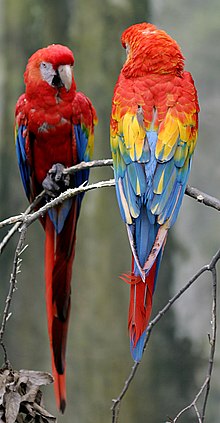
The Wildlife of Republic of costa rica comprises all naturally occurring animals, fungi and plants that reside in this Primal American country. Costa Rica supports an enormous diversity of wildlife, due in large part to its geographic position between the N and South American continents, its neotropical climate, and its wide diverseness of habitats. Costa Rica is home to more than 500,000 species, which represents virtually 5% of the total species estimated worldwide, making Republic of costa rica one of the twenty countries with the highest biodiversity in the world. Of these 500,000 species, a petty more than than 300,000 are insects.[one]
I of the primary sources of Costa Rica's biodiversity is that the land, together with the land now considered Panama, formed a bridge connecting the North and South American continents approximately iii to five meg years agone. This span allowed the very different flora and fauna of the 2 continents to mix.[ii]
Biodiversity [edit]
Costa Rica is considered to possess the highest density of biodiversity of any land worldwide.[iii] While encompassing just one thirtieth of a pct of Globe's landmass, Costa rica contains four percent of species estimated to exist on the planet.[4] Hundreds of these species are endemic to Republic of costa rica, meaning they exist nowhere else on world. These owned species include frogs, snakes, lizards, finches, hummingbirds, gophers, mice, cichlids, and gobies among many more than.[5]
Costa Rica has 3 UNESCO Globe Heritage sites that are all natural avails and are as follows:
- The Talamanca Mount Range – La Amistad Reserves / International Friendship Park (declared in 1983)
- The Isla del Coco National Park (declared in 1997)
- The Guanacaste Conservation Area (declared in 1999). [6]

Costa Rica'south biodiversity tin be attributed to the multifariousness of ecosystems inside the land. Tropical rainforests, deciduous forests, Atlantic and Pacific coastline, cloud forests, and mangrove forests are all represented throughout the 19,730 square miles of Costa Rica's landmass.[7] The ecological regions are twelve climatic zones. This variation provides numerous niches which are filled by a diversity of species.
Benefits for humanity [edit]
Republic of costa rica demonstrates biodiversity conservation for developing countries. Over xx-seven pct of the country's country has a protected status every bit national parks, wildlife refuges, forest preserves, and more.[8] The Costa Rican authorities is agile in protecting its biodiversity for the ecological services they provide. The government imposes a five pct taxation on gasoline to generate acquirement to pay landowners to refrain from clear-cutting on their land and instead to create tree plantations. This provides Costa Ricans, or "Ticos" as they phone call themselves, incentive to become active tree farmers instead of cattle ranchers.[9] Tree farms provide some habitat for wild fauna, enabling some measure out of biodiversity to remain in these areas despite humans' utilize of these natural resources.
Costa rica's biodiversity contributes to the numerous ecological services the environment provides. Every attribute of the ecosystem from the dissimilar species of plants to the multifariousness of beast species contributes to natural services like h2o purification, provision of food, fuel, fiber, and biochemicals, nutrient cycling, pollination and seed dispersal, and climate regulation, just to name a few.[ten] As the diversity of species increases, more of these services can be provided and to a greater extent.
Biodiversity has contributed to the economy of Republic of costa rica. Ecotourism brings in i.92 billion dollars in revenue for the country.[11] Ecotourism is defined as "tourism directed toward exotic, often threatened, natural environments, especially to support conservation efforts and observe wildlife." Costa Rica's abundant biodiversity makes the country an attractive destination for ecotourism. Thirty-nine percent of tourists cite nature equally their primary reason for visiting the country.[12] The assisting industry of ecotourism entices businesses to capitalize on natural resources by protecting and preserving them rather than consuming them.
Threats to biodiversity [edit]
Threats to Costa Rica's biodiversity include a rapidly growing man population, developing coastlines for the industry of tourism and harmful agricultural practices all contributing to pollution and ecology degradation. The practise causing the largest concern for Costa rica'due south environment is deforestation. Costa rica has the fourth highest rate of deforestation in the globe. Almost iv percent of its current forested lands are cut each year. Immigration country for cattle ranching is the nearly common cause of deforestation. This grade of environmental harm along with the farming of monocultures leads to areas where but a few species of plants are nowadays. Ultimately, decreases in plant diversity leads to decreased animate being diversity.[xiii]
Insects [edit]
Butterflies and moths [edit]

![]()
In that location are nigh i,251 species of butterflies and at least viii,000 species of moths. Butterflies and moths are common year round but are more present during the rainy season. Ten percent of known butterfly species worldwide reside in Costa rica.[fourteen]
Costa Rican butterflies and moths take made astonishing adaptations to the environs. Some examples of these are the following:
- Swallowtail caterpillars imitate bird debris and many others have bright colours to warn predators of bodily toxins.
- What someone could easily mistake for a butterfly, a wasp, or a leaf in Republic of costa rica might be a moth engaging in Müllerian or Batesian mimicry.
Ecotourism is one of Costa Rica's chief economic resources, and the country's butterflies add a lot to that. They bring life to tropical forests, non but with the diversity in colour, but with the magnificence of the flowers that they aid pollinate.
Some mutual butterflies and moths in Republic of costa rica include:
- Thoas swallowtail
- Marpesia berania
- Doxocopa laure
- Banded peacock
- Zebra longwing
- Morpho butterfly
- Green page moth
- Glasswing
Some notable insects in Costa rica are stingless bees and sweat bees such equally Fifty. figueresi and L. aeneiventre, ants such as leaf-cutter ants and army ants, Hercules beetle, and many katydids.
Other invertebrates [edit]
Invertebrate species brand up most of Costa Rica'southward wildlife. Of the estimated 500,000 species, nigh 493,000 are invertebrates (including spiders and crabs). It is known that at that place are tens of thousands of insects and microscopic invertebrates in every land type and superlative level. Even so, they are largely unnoticed or unidentified.
There are known 183[15] species and subspecies of terrestrial gastropods from Republic of costa rica and numerous freshwater gastropods and bivalves.
Amphibians [edit]
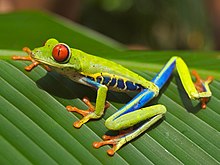
Costa rica is home to effectually 175 amphibians, 85% of which are frogs. Frogs in Costa Rica accept interesting ways of finding fishless water to raise their young in. Fish, of course, will eat tadpoles and eggs. Poison sprint frogs put their eggs in water pools in bromeliads. Other methods include searching ponds before laying eggs, and laying eggs in moisture soil. In that location are 35 species of Elutherodoctylus frogs, 26 species of Hyla frogs and 13 species of glassfrogs.
Notable frog species in Republic of costa rica include red-eyed tree frog, a few species of poison dart frogs, the semitransparent glassfrogs, and the large smoky jungle frog. Another notable toad species in Republic of costa rica include the 10 species of Bufo toads and the giant toad, a huge toad known for its wide appetite. It has been documented eating almost anything, including vegetables, ants, spiders, whatsoever toad smaller than itself, mice, and other modest mammals.
Besides the frog species, approximately 40 species of lungless salamander and two species of caecilian are found in the country, both rarely seen and piddling known. Costa Rican amphibians range in size from the rainforest rocket frog, at 1.v cm (0.5 in), to the giant toad, at up to 15 cm (vi in) and 2 kg (4.four lb).
Representatives of all three orders of amphibians - caecilians, salamanders, and frogs and toads - reside in Costa rica. Due to environmental degradation and the sensitive nature of amphibians to pollution, Costa Rica has seen declines and fifty-fifty extinctions in amphibian populations. Monteverde Cloud Woods Reserve is a disquisitional habitat for certain species of the order Anura. However, xl pct of the members of this guild that reside in this reserve are estimated to have gone extinct since 1987. This equals xx species of frogs and toads.[16]
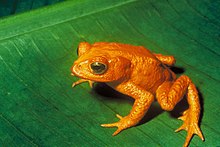
The golden toad, an amphibian one time endemic to Costa rica, is at present extinct.
The highland-dwelling golden toad, Bufo periglenes, has not been witnessed in its highly restricted habitat of the key mountain ranges of Republic of costa rica since 1989. Within one year, the number of juveniles counted at their about prevalent convenance site declined from over i,500 individuals to simply 1. The International Union for the Conservation of Nature (IUCN) alleged the aureate toad endangered, but it is likely extinct due to the lack of sightings since over two decades ago. Suspected causes for the toads probable extinction include a combination of intense El Nino weather condition patterns which resulted in a drought, increased pollution added to the surroundings, climate change, and an invasive fungal species, Chiriqui harlequin.[16]
Amphibians in Costa Rica have caused many adaptations for survival. Some frog species, especially those of the toxicant dart frogs, have learned to lay eggs in water devoid of predatory fish. For some species this means laying eggs in small collections of h2o in the leaf litter, and then transporting the eggs to bromeliads. Other species accept adapted the ability of straight development. This means that the frog develops completely inside the egg without transitioning to the tadpole phase. This decreases vulnerable exposure to predators and the frog emerges from its egg as a froglet, much better equipped to protect itself.[17]
Reptiles [edit]
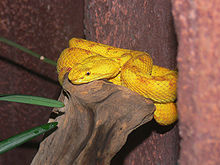
Approximately 225 types of reptiles are found in Costa Rica. This includes over 70 species of lizards, by and large pocket-size, woods-home anoles. Large lizards such as the striped basilisk, black iguana, and light-green iguana are probably the land'due south most regularly encountered reptiles. Snakes number about 120 species in the state, including 5 powerful boas and a wide diversity of harmless colubrids.
There are virtually 20 venomous snakes, including colorful coral snakes and various vipers such as the mutual eyelash viper and two formidable, large bushmasters. The venomous snakes of Costa Rica are often observed without issue if given a respectful altitude.
Among turtles, 5 of the world's 7 species of body of water turtles nest on the nation'southward beaches. 2 crocodilians, the widespread spectacled caiman and the large, sometimes dangerous American crocodile are constitute in Republic of costa rica. The country's reptiles range in size from the delicate fifteen cm (6 in) Hallowell'southward centipede snake of the genus Tantilla to the hulking leatherback turtle, at 500 kg (1100 lb) and 150 cm (lx in).
Mammals [edit]

Costa Rica is abode to nearly 250 species of mammal. Medium-sized wood-domicile mammals are oft the almost appreciated mammalian animate being of the country. These include four species of monkeys such every bit the frantic white-headed capuchin and noisy mantled howlers; ii species of sloths; the opportunistic white-nosed coati; and the tearing predator, the tayra.
Bats incorporate more than half of the mammal species in the country, unusually outnumbering rodents twice over. Bats are adapted to various foraging methods and foods; including nectar, fish, insects and parasitized blood, as the instance with the infamous vampire bats. Prominent bats include the tiny, communal roosting Honduran white bat and the huge, predatory spectral bat, the largest New World bat. Large fauna, such equally tapir, jaguar, and deer are rarely encountered, being both elusive and tied to now-fragmented undisturbed habitats. Costa Rican mammals range in size from the 3-gram thumbless bat of the family unit Furipteridae to the 250 kg (550 lb) Baird'southward tapir.
Anteaters are mutual in lowland and middle superlative throughout Costa rica. The almost unremarkably seen of Costa rica'due south three anteaters species is the northern tamandua. The giant anteater is huge and endangered. The other anteater is the silky anteater.
Wild cats [edit]
Wild cats that exist in Republic of costa rica are: jaguars, ocelots, pumas, jaguarundi, margays, and little spotted cats.
Most big cats in Republic of costa rica are nocturnal or hide in trees in the rainforest like the margay. The most likely place to find a big cat is in the Simon Bolivar Zoo in San José, Costa Rica where there is a selection of all the native big cats along with other animals. Ocelots usually hunt on the ground at night and rarely climb trees. An ocelot's diet consists of birds, monkeys, rats, and other small animals. The little spotted true cat is the smallest wild cat and does not grow bigger than a house true cat. They live in cloud forests up to 3200 one thousand.
The jaguar is the largest wild cat in Costa Rica and tin can abound up to 2 thou. They are very rare in Costa rica and their numbers continue to reject drastically. The jaguarundi looks like a cross betwixt a weasel and a cat. Information technology is plain grey with a sleek torso, hunts 24-hour interval and night, and has adapted best to human changes. The margay spends near of its life in trees. The puma is the second largest true cat in Key America and its fur is dark-brown and unspotted.
Birds [edit]

941 bird species have been recorded in Republic of costa rica (including Cocos Island), more than than all of the U.s.a. and Canada combined. More than 600 of the Costa Rican species are permanent residents, and upward of 200 are migrants, spending portions of the twelvemonth exterior of the land, usually in Northward America. 7 of the Costa Rican species are considered endemic, and 19 are globally threatened. Costa rica'southward birds range in size from the scintillant hummingbird, at 2.2 grams and 6 cm (2.4 in), to the huge jabiru, at 6.5 kg (14.3 lb) and 150 cm (60 in) (the American white pelican is heavier, but is an adventitious species).
Ruddy macaws are a common species of Costa Rica. Unlike many bird species, macaws form a monogamous breeding pair and mate for life. Both males and females help care for young and heighten chicks for upwards to two years earlier they fledge. Threats to the macaw include their popularity in the pet merchandise. One individual can be sold for upwardly to one thousand dollars.[18]
The resplendent quetzal, a trogon with a stunning physical advent, can also exist constitute in parts of Costa Rica. The bird's long grey and black tail feathers can stretch up to a meter long and are its defining feature. Resplendent quetzals live in cloud forests and are most active in the canopy. They can be found in several of Republic of costa rica'due south parks and reserves, including the Monteverde Cloud Wood, Santa Elena Cloud Forest Reserve, Braulio Carrillo National Park, Poas Volcano National Park, Chirripo National Park, and the Juan Castro Blanco National Park. Resplendent quetzals swallow fruit, insects, small frogs, lizards, and snails and have distinctive echoing calls. Unfortunately, the bird is endangered because its cloud forest habitat has been widely destroyed across Central America.[xix]
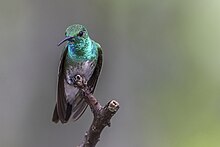
The mangrove hummingbird is endemic to Costa rica and specializes in feeding from the tea mangrove found with its uniquely shaped bill.
Hummingbird species demonstrate accommodation with bill shape and size. Certain species take specialized bills that allow them to feed from the flowers of sure species of plants. The relationship between the hummingbird and plant is mutualistic considering the hummingbird transfers pollen betwixt institute individuals in commutation for nectar. Considering different species of hummingbirds are adapted to specific plants, [pollination] of the right plants with the right pollen is ensured.[xviii] The mangrove hummingbird is endemic to Republic of costa rica and specializes in feeding from the tea mangrove establish.[5] [20]
Costa Rican officials take explored the possibility of shutting down their national zoos in an effort to demonstrate a more advanced appreciation for the wildlife in their state.[21]
Run across also [edit]
- Instituto Nacional de Biodiversidad
- Deforestation in Republic of costa rica
References [edit]
- ^ "Biodiversity in Costa rica". Archived from the original on 2011-11-18. Retrieved 2007-04-18 .
- ^ Stiles, Gary Slater and Alexander F. Skutch. A Guide to the Birds of Costa rica. Ithaca, New York: Cornell University Press, 1989.
- ^ Obando, Vilma. "Biodiversidad en Republic of costa rica". INBio-Sinac. INBio-Sinac. Archived from the original on 2018-11-15. Retrieved 2012-04-02 .
- ^ "Biodiversity in Republic of costa rica". INBio. INBio. Archived from the original on 2011-11-xviii. Retrieved 2007-04-xviii .
- ^ a b "Costa Rica". Living National Treasures. Living National Treasures. Retrieved 2 Apr 2012.
- ^ "Biodiversidad de Costa Rica", Wikipedia, la enciclopedia libre (in Castilian), 2021-05-eighteen, retrieved 2021-06-03
- ^ "Ecological Zones". Cupotico.com. Cupotico.com. Archived from the original on 27 December 2014. Retrieved ii April 2012.
- ^ Holl, Karen; Daily, Gretchen; Ehrlich, Paul (December 1995). "Knowledge and Perceptions in Costa Rica Regarding Environment, Population, and Biodiversity Bug". Conservation Biology. ix (6): 1548–1558. doi:ten.1046/j.1523-1739.1995.09061548.x. JSTOR 2387198.
- ^ Burnett, John (February 18, 2008). "Republic of costa rica Aims to Be a Carbon-Neutral Nation". National Public Radio . Retrieved 2 Apr 2012.
- ^ "Biodiversity and Homo Well-Beingness". GreenFacts. Cogeneris sprl. Retrieved 2 April 2012.
- ^ Rose, Wesley (March 12, 2012). "Costa Rica: Unequaled Tradition Of Political, Social and Economic Stability". Within Costa rica . Retrieved three April 2012.
- ^ Menkhaus, Susan; Lober, Douglas (1996). "International Ecotourism and the Valuation of Tropical Rainforests in Costa Rica" (PDF). Periodical of Environmental Management. 47: i–10. doi:10.1006/jema.1996.0031. Archived from the original (PDF) on 2014-05-17. Retrieved 2012-04-03 .
- ^ Beletsky, Les. "Conservation in Costa Rica". Costa rica: The Ecotravellers' Wild animals Guide. planeta.com. Retrieved 3 April 2012.
- ^ "Costa Rica Facts". The Living Centre. The Living Centre. Archived from the original on 2012-05-08. Retrieved 2013-06-03 .
- ^ (in Spanish) Barrientos Z. (2003). "Lista de especies de moluscos terrestres (Archaeogastropoda, Mesogastropoda, Archaeopulmonata, Stylommatophora, Soleolifera) informadas para Costa rica". Rev. Biol. Trop. 51(Suppl. 3): 293-304. PDF Archived 2012-02-28 at the Wayback Automobile
- ^ a b Natalie, Fath. "Amphibian Declines in Costa rica". Miami Academy . Retrieved 3 April 2012.
- ^ Henderson, Carrol (2010). Mammals, Amphibians, and Reptiles of Costa rica: A Field Guide . Austin, TX: University of Texas Printing. pp. 87.
- ^ a b Bermingham, Adrienne. "Birds". Canisius Higher Ambassadors for Conservation. Institute for the Study of Human being-animal Relations.
- ^ Stater, Adam. "Resplendent Quetzals in Costa Rica".
- ^ Johnson, Sibylle. "Mangrove Hummingbirds". Beautyofbirds (formerly Avianweb). Beautyofbird.
- ^ "Costa Rica to close zoos, release some animals". Baronial 8, 2013.
External links [edit]
- Organization for Tropical Studies
- Pictures of flora and fauna
- Costa Rica Wildlife
Source: https://en.wikipedia.org/wiki/Wildlife_of_Costa_Rica
Posted by: higginshavem1951.blogspot.com

0 Response to "What Is The Climate In Costa Rica What Animals Are Native To Costa Rica"
Post a Comment